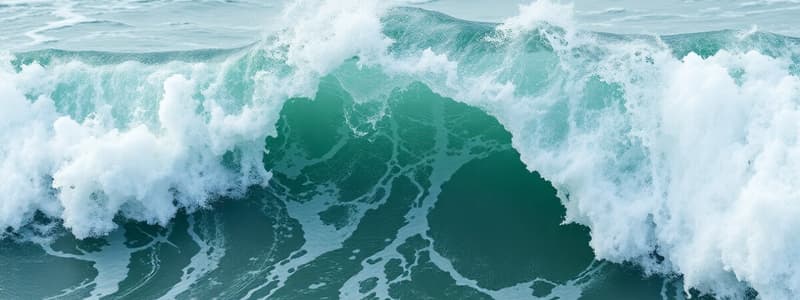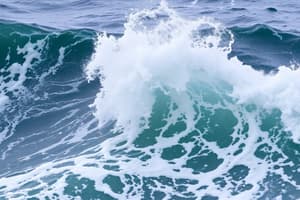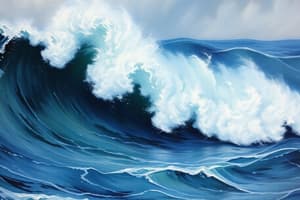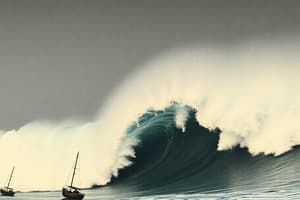Podcast
Questions and Answers
What is the primary material that coral polyps secrete to form coral reefs?
What is the primary material that coral polyps secrete to form coral reefs?
- Silica
- Calcium carbonate (correct)
- Sodium chloride
- Phosphate
Which temperature range is essential for coral reefs to thrive?
Which temperature range is essential for coral reefs to thrive?
- 23-29°C (correct)
- 15-20°C
- 20-25°C
- 30-35°C
What is a major negative impact of muddy or turbid water on coral reefs?
What is a major negative impact of muddy or turbid water on coral reefs?
- Balances salinity levels
- Reduces light penetration (correct)
- Enhances coral growth
- Increases oxygen levels
Which type of reef is directly attached to the shore?
Which type of reef is directly attached to the shore?
How do coral reefs provide economic support to local communities?
How do coral reefs provide economic support to local communities?
What is a consequence of climate change for coral reefs?
What is a consequence of climate change for coral reefs?
Which action is NOT a way humans negatively impact coral reefs?
Which action is NOT a way humans negatively impact coral reefs?
Which type of coral reef forms a ring around a lagoon?
Which type of coral reef forms a ring around a lagoon?
What method of erosion involves the force of water compressing air in rock cracks?
What method of erosion involves the force of water compressing air in rock cracks?
Which process describes the breakdown of rocks into smaller particles due to collisions with each other?
Which process describes the breakdown of rocks into smaller particles due to collisions with each other?
In the context of wave transport, what is defined as larger particles bouncing along the seabed?
In the context of wave transport, what is defined as larger particles bouncing along the seabed?
Which of the following processes directly describes how sediment is transported along the coastline?
Which of the following processes directly describes how sediment is transported along the coastline?
What geological feature is formed by softer rock eroding faster than harder rock, resulting in a protrusion into the sea?
What geological feature is formed by softer rock eroding faster than harder rock, resulting in a protrusion into the sea?
Which term describes a coastal body of water that is partially surrounded by land?
Which term describes a coastal body of water that is partially surrounded by land?
What is the primary biological structure built by coral polyps in a coral reef?
What is the primary biological structure built by coral polyps in a coral reef?
What type of erosion occurs when sediment carried by waves scrapes and wears away rock surfaces?
What type of erosion occurs when sediment carried by waves scrapes and wears away rock surfaces?
What primarily forms waves on water surfaces?
What primarily forms waves on water surfaces?
What happens to a wave as it approaches shallow water?
What happens to a wave as it approaches shallow water?
Which statement accurately defines a destructive wave?
Which statement accurately defines a destructive wave?
What term describes the highest point of a wave?
What term describes the highest point of a wave?
What does the term 'swash' refer to in wave action?
What does the term 'swash' refer to in wave action?
What is the primary difference between constructive and destructive waves?
What is the primary difference between constructive and destructive waves?
What is the process called when a wave's energy is compressed as it approaches the shore?
What is the process called when a wave's energy is compressed as it approaches the shore?
Where are destructive waves particularly observable in Barbados?
Where are destructive waves particularly observable in Barbados?
Flashcards
Wave
Wave
A disturbance transferring energy through matter or space by vibrations.
Wave Formation
Wave Formation
Primarily formed by wind interacting with water's surface, transferring energy, starting as ripples, building to larger waves.
Wave Breaking
Wave Breaking
Occurs when shallow water compresses wave energy, causing the crest to fall, making it a breaking wave.
Constructive Wave
Constructive Wave
Signup and view all the flashcards
Destructive Wave
Destructive Wave
Signup and view all the flashcards
Swash
Swash
Signup and view all the flashcards
Backwash
Backwash
Signup and view all the flashcards
Barbados Coastlines
Barbados Coastlines
Signup and view all the flashcards
Hydraulic Action
Hydraulic Action
Signup and view all the flashcards
Abrasion
Abrasion
Signup and view all the flashcards
Wave-cut Platform
Wave-cut Platform
Signup and view all the flashcards
Longshore Drift
Longshore Drift
Signup and view all the flashcards
Headland
Headland
Signup and view all the flashcards
Bay
Bay
Signup and view all the flashcards
Coral Reef
Coral Reef
Signup and view all the flashcards
Attrition
Attrition
Signup and view all the flashcards
Coral Reef Formation
Coral Reef Formation
Signup and view all the flashcards
Coral Reef Thrive Conditions
Coral Reef Thrive Conditions
Signup and view all the flashcards
Negative Impacts
Negative Impacts
Signup and view all the flashcards
Fringing Reef
Fringing Reef
Signup and view all the flashcards
Barrier Reef
Barrier Reef
Signup and view all the flashcards
Atoll
Atoll
Signup and view all the flashcards
Coral Bleaching Cause
Coral Bleaching Cause
Signup and view all the flashcards
Climate Change Coral Threat
Climate Change Coral Threat
Signup and view all the flashcards
Study Notes
Wave Action
- Waves transfer energy through matter or space, oscillating around a rest position.
- Waves are primarily formed by wind friction on water's surface, creating ripples that develop into larger waves.
- Wave breaking occurs when a wave enters shallow water, the bottom interacts, energy compresses, and the crest falls over.
- Constructive waves have gentle slopes, carry sediment onshore, and contribute positively to beach formation. They have a longer wavelength.
- Destructive waves have steeper slopes, higher energy, erode coastlines, pulling sediment back into the sea, and causing beaches to narrow. They have shorter wavelengths.
- Crest: Highest point of a wave.
- Trough: Lowest point of a wave.
- Wavelength: Distance between two successive crests or troughs.
- Wave height: Vertical distance between crest and trough.
- Swash: Water moving up the beach when a wave breaks.
- Backwash: Water flowing back down the beach to the sea.
- Destructive waves are often more intense and noticeable along the east and south coasts of Barbados.
How Waves Erode Land
- Hydraulic action: Water pressure in cracks of rocks causes them to break apart.
- Abrasion: Rocks and sediment carried by waves wear down surfaces they collide with.
- Attrition: Rocks collide with each other, breaking into smaller pieces.
- Solution: Seawater dissolves soluble materials in rocks, causing erosion.
Transport of Eroded Material
- Suspension: Small particles carried within the water column.
- Saltation: Larger particles bouncing along the seabed.
- Traction: Heavy materials are rolled along the seabed.
- Dissolution: Soluble materials are dissolved and carried away in water.
Longshore Drift
- Longshore drift is the process where sediment is moved along a coastline due to waves hitting the shore at an angle. The water receding pulls sediment back down the beach, creating an angled zigzag pattern.
Headlands and Bays
- Headland: A rocky point of land extending into the sea, formed by more resistant rock remaining after softer rocks are eroded.
- Bay: A coastal body of water partially enclosed by land, typically found between headlands where weaker rock has weathered away faster.
Coral Reefs
- Coral reefs are diverse underwater ecosystems formed by colonies of coral polyps, building calcium carbonate structures.
- Necessary conditions for thriving coral reefs include water temperatures between 23-29°C, clear sunlight, sufficient salinity, and well-aerated water.
- Negative impacts on coral reefs can include turbid or polluted water, hindering photosynthesis, and causing algal blooms.
- Coral reefs provide habitats for numerous marine species, protect coastlines from erosion and storm surges, contribute to tourism and local economies, and serve as a critical food source for coastal communities.
- Human activities like Coastal development, overfishing, pollution, climate change, and tourist impacts can negatively affect coral reef health.
- Climate change impacts can cause coral bleaching, a stress response causing coral to expel symbiotic algae and lose color and nutrients. Ocean acidification weakens coral's ability to build calcium carbonate skeletons, threatening reef structures.
- Different types of coral reefs exist: fringing reefs, barrier reefs, and atolls.
Studying That Suits You
Use AI to generate personalized quizzes and flashcards to suit your learning preferences.




